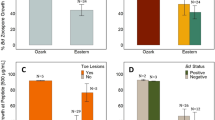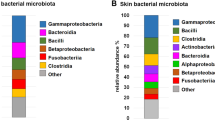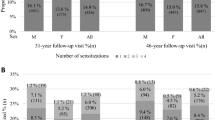Abstract
HUMAN cerumen (ear wax) occurs in two phenotypic forms, wet and dry, believed to be controlled by a single pair of genes in which the wet allele is dominant over the dry. Mongoloid peoples, including American Indians, characteristically have high frequencies of the dry allele, whereas among Caucasians and Negroes the wet allele predominates1–3. Although no reason for this genetic dimorphism has been found4,5, the extreme variations in frequencies of the two alleles among human populations suggest some adaptive value, possibly with respect to disease resistance. In this study, dry and wet cerumen was examined for the presence of lysozyme and immunoglobulins which are known to be present in nasal secretions, tears, saliva, and to play a role in resistance to infection6–8.
This is a preview of subscription content, access via your institution
Access options
Subscribe to this journal
Receive 51 print issues and online access
$199.00 per year
only $3.90 per issue
Buy this article
- Purchase on Springer Link
- Instant access to full article PDF
Prices may be subject to local taxes which are calculated during checkout
Similar content being viewed by others
References
Matsunaga, E., Ann. Human Genet., 25, 273 (1962).
Petrakis, N. L., Molohan, K. T., and Tepper, D. J., Science, 158, 1192 (1967).
Petrakis, N. L., Nature, 222, 1080 (1969).
Senturia, B. H., Diseases of the External Ear (Thomas, Springfield, Illinois, 1957).
Perry, E. T., The Human Ear Canal, (Thomas, Springfield, Illinois, 1957).
Salton, M. R. J., Bact. Rev., 21, 82 (1957).
Tomasi, T. B., New Engl. J. Med., 119, 21 (1964).
Douglas, R. G., Rossen, R. D., Butler, W. T., and Couch, R. B., J. Immunol., 99, 297 (1967).
Osserman, E. F., and Lawlor, D. P., J. Exp. Med., 124, 921 (1966).
Crowle, A. J., Immunodiffusion (Academic Press, New York and London, 1961).
Perry, E. T., and Nichols, E. T., J. Invest. Dermatol., 27, 165 (1956).
Skarnes, R. C., and Watson, D. W., Bact. Rev., 21, 273 (1957).
McCullough, J. M., and Giles, E., Nature, 226, 460 (1970).
Mawson, S. R., Diseases of the Ear, second ed. (Edward Arnold, London, 1967).
Zonis, R. D., Arch. Otolaryngol., 88, 360 (1968).
Author information
Authors and Affiliations
Rights and permissions
About this article
Cite this article
PETRAKIS, N., DOHERTY, M., LEE, R. et al. Demonstration and Implications of Lysozyme and Immunoglobulins in Human Ear Wax. Nature 229, 119–120 (1971). https://doi.org/10.1038/229119a0
Received:
Revised:
Issue Date:
DOI: https://doi.org/10.1038/229119a0
This article is cited by
-
Human antimicrobial proteins in ear wax
European Journal of Clinical Microbiology & Infectious Diseases (2011)
-
Besteht ein Zusammenhang zwischen Ceruminalhypersekretion (CHp) und Mamma-Ca-H�ufigkeit?
Archives of Oto-Rhino-Laryngology (1979)
-
Utilization of somatic cell hybrids for genetic studies in man
Humangenetik (1973)
Comments
By submitting a comment you agree to abide by our Terms and Community Guidelines. If you find something abusive or that does not comply with our terms or guidelines please flag it as inappropriate.



